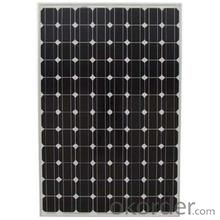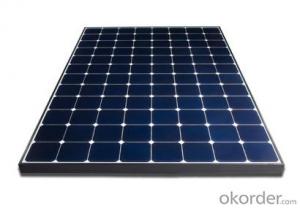CNBM On Grid System 10KW with Certificate UL TUV CE
- Loading Port:
- Shanghai
- Payment Terms:
- TT OR LC
- Min Order Qty:
- 100 watt
- Supply Capability:
- 1000 watt/month
OKorder Service Pledge
OKorder Financial Service
You Might Also Like
Item specifice
CNBM On Grid System 10KW with Certificate UL TUV CE
Product description
They range from small residential and commercial rooftop systems to large utility-scale solar power stations. Unlike stand-alone power systems, a grid-connected system rarely includes an integrated battery solution, as they are still very expensive. When conditions are right, the grid-connected PV system supplies the excess power, beyond consumption by the connected load, to the utility grid.
Connection of the photovoltaic power system can be done only through an interconnection agreement between the consumer and the utility company. The agreement details the various safety standards to be followed during the connection.[4]
Bypass diodes may be incorporated or used externally, in case of partial module shading, to maximize the output of module sections still illuminated.Systems such as Net Metering and Feed-in Tariff which are offered by some system operators, can offset a customers electricity usage costs. In some locations though, grid technologies cannot cope with distributed generation feeding into the grid, so the export of surplus electricity is not possible and that surplus is earthed.
Grid-connected PV systems are comparatively easier to install as they do not require a battery system.[1][6]
Grid interconnection of photovoltaic (PV) power generation systems has the advantage of effective utilization of generated power because there are no storage losses involved.[7]

Application
Industrial
Commercial
Residential
Feature
Residential, grid-connected rooftop systems which have a capacity more than 10 kilowatts can meet the load of most consumers.[2] They can feed excess power to the grid where it is consumed by other users. The feedback is done through a meter to monitor power transferred. Photovoltaic wattage may be less than average consumption, in which case the consumer will continue to purchase grid energy, but a lesser amount than previously. If photovoltaic wattage substantially exceeds average consumption, the energy produced by the panels will be much in excess of the demand. In this case, the excess power can yield revenue by selling it to the grid. Depending on their agreement with their local grid energy company, the consumer only needs to pay the cost of electricity consumed less the value of electricity generated. This will be a negative number if more electricity is generated than consumed.[3] Additionally, in some cases, cash incentives are paid from the grid operator to the consumer.
Packaging
With carton and box
- Q:Can solar energy systems be used in powering telecommunications towers?
- Yes, solar energy systems can be used to power telecommunications towers. Solar panels can be installed on the towers or nearby to capture sunlight and convert it into electricity. This clean and renewable energy source can provide a reliable power supply for telecommunications equipment, especially in remote or off-grid locations where access to traditional power sources may be limited or costly. Additionally, solar energy systems can help reduce operating costs and dependency on fossil fuels, making them an environmentally friendly choice for powering telecommunications towers.
- Q:Can solar energy systems be used for powering satellites?
- Yes, solar energy systems can be used for powering satellites. Solar panels are often used to capture the sun's energy and convert it into electricity, which can then be used to power various systems on board satellites. This clean and renewable energy source is highly efficient in space, where sunlight is readily available and there are no obstructions to hinder solar panel performance.
- Q:Can solar energy systems be used for powering off-grid transportation systems?
- Yes, solar energy systems can be used for powering off-grid transportation systems. Solar-powered vehicles, such as solar cars, bikes, and boats, have been developed and can operate independently from traditional power grids. These systems harness the sun's energy through solar panels, which convert sunlight into electricity to power the vehicles' motors. Off-grid transportation systems benefit from solar energy as they rely on sustainable and renewable power sources, reducing their carbon footprint and dependence on fossil fuels.
- Q:Can solar energy systems be used for powering public transportation systems like buses or trains?
- Yes, solar energy systems can be used for powering public transportation systems like buses or trains. Solar panels can be installed on the rooftops or in dedicated areas near the transportation infrastructure to generate electricity from sunlight. This renewable energy can then be used to charge the electric batteries of buses or trains, reducing their reliance on fossil fuels and lowering carbon emissions. Additionally, solar-powered charging stations can be set up along the transportation routes to ensure continuous energy supply.
- Q:Can solar energy systems be used for recreational vehicles or boats?
- Yes, solar energy systems can be used for recreational vehicles or boats. These systems can provide power for various appliances and electronics, making them suitable for off-grid camping or sailing. Solar panels can be installed on the roof or deck of the vehicle or boat, and the energy generated can be stored in batteries for later use. This allows for a sustainable and convenient power source while enjoying outdoor activities.
- Q:How do solar energy systems impact the energy consumption of buildings?
- Buildings' energy consumption is significantly impacted by solar energy systems. These systems harness the sun's power to generate clean and renewable electricity, which can offset the need for grid-based energy. One of the main ways solar energy systems affect energy consumption is by decreasing reliance on non-renewable sources like fossil fuels. Coal, oil, and natural gas, which are traditional energy sources, contribute to greenhouse gas emissions and global warming. Conversely, solar power produces electricity without emitting any harmful substances, making it an environmentally friendly alternative. Additionally, solar systems help reduce a building's overall energy demand. By generating electricity on-site, buildings can decrease their dependence on the electrical grid. This not only lessens the strain on the grid but also lowers the risk of power outages during periods of peak demand or natural disasters. Moreover, solar energy systems can lead to financial savings for building owners. When solar panels generate electricity, the building consumes less power from the grid, resulting in reduced utility bills. In some cases, surplus energy generated by the solar system can be sent back to the grid, allowing building owners to earn credits or even receive payments from utility companies through net metering programs. Furthermore, solar energy systems offer long-term benefits for buildings. Solar panels have a lifespan of approximately 25 to 30 years, and their maintenance costs are relatively low compared to other energy systems. This implies that once the initial investment is recovered, the building can enjoy years of clean and affordable energy. To conclude, solar energy systems positively impact buildings' energy consumption by reducing reliance on non-renewable sources, lowering overall energy demand, providing financial savings, and offering long-term sustainability.
- Q:Can solar energy systems be used in urban environments?
- Yes, solar energy systems can definitely be used in urban environments. In fact, urban areas can be ideal for solar energy due to the high population density and availability of rooftop spaces. Solar panels can be installed on buildings, homes, and other structures in cities to harness the power of the sun and provide clean and renewable energy. Additionally, advancements in solar technology have made it possible to integrate solar panels into various urban infrastructure, such as streetlights and bus stops, further expanding the use of solar energy in urban environments.
- Q:Can solar energy systems be used for powering sports stadiums?
- Yes, solar energy systems can be used for powering sports stadiums. Many sports stadiums around the world have already implemented solar energy systems to meet a portion or even all of their electricity needs. These systems typically consist of solar panels installed on the stadium roofs or in adjacent areas to harness sunlight and convert it into electricity. The generated energy can then be used to power the stadium's lighting, scoreboard, sound systems, and other electrical equipment. Utilizing solar energy helps reduce the carbon footprint of sports stadiums and promotes a more sustainable and environmentally friendly approach to powering large venues.
- Q:How do solar energy systems impact the carbon footprint of a home?
- The carbon footprint of a home can be significantly reduced by solar energy systems. These systems utilize the power of the sun to generate clean and renewable energy, resulting in a notable decrease in greenhouse gas emissions. Traditional methods of electricity generation heavily rely on fossil fuels like coal, oil, and natural gas. Unfortunately, these fuels release carbon dioxide and other harmful pollutants into the atmosphere. Such emissions contribute to global warming, air pollution, and various negative effects on human health and the environment. In contrast, solar energy systems generate electricity without any emissions or air pollution. The photovoltaic cells in solar panels directly convert sunlight into electricity, leaving no room for combustion or the creation of harmful byproducts. Consequently, solar energy systems eliminate greenhouse gas emissions and reduce the dependence on fossil fuels. By embracing solar power, homeowners can significantly minimize their carbon footprint. The extent of carbon dioxide emissions avoided depends on factors such as the size and efficiency of the solar energy system, as well as the amount of electricity consumed. On average, a typical residential solar energy system can offset approximately 15,000 pounds of carbon dioxide emissions per year. This is equivalent to planting around 150 trees annually or driving a car for 10,000 miles. Furthermore, solar energy systems enable homeowners to achieve energy independence and reduce their reliance on the electrical grid. By generating their own clean electricity, homeowners can decrease the demand for energy sources based on fossil fuels, ultimately leading to a broader reduction in carbon emissions. To summarize, solar energy systems have a profound impact on the carbon footprint of a home. They offer a sustainable and environmentally friendly alternative to traditional electricity generation, resulting in the reduction of greenhouse gas emissions and the mitigation of climate change. Installing solar panels not only helps homeowners save money on electricity bills but also contributes to a cleaner and healthier planet for future generations.
- Q:How does the efficiency of solar panels vary across different installation angles?
- The efficiency of solar panels varies across different installation angles due to the changing angle of incidence of sunlight. Solar panels are most efficient when they are installed at an angle that allows them to receive direct sunlight perpendicular to their surface. When the installation angle deviates from this optimal position, the efficiency decreases as the angle of incidence increases or decreases. Hence, finding the right installation angle is crucial to maximize the efficiency of solar panels and ensure optimal energy generation.
1. Manufacturer Overview |
|
|---|---|
| Location | |
| Year Established | |
| Annual Output Value | |
| Main Markets | |
| Company Certifications | |
2. Manufacturer Certificates |
|
|---|---|
| a) Certification Name | |
| Range | |
| Reference | |
| Validity Period | |
3. Manufacturer Capability |
|
|---|---|
| a)Trade Capacity | |
| Nearest Port | |
| Export Percentage | |
| No.of Employees in Trade Department | |
| Language Spoken: | |
| b)Factory Information | |
| Factory Size: | |
| No. of Production Lines | |
| Contract Manufacturing | |
| Product Price Range | |
Send your message to us
CNBM On Grid System 10KW with Certificate UL TUV CE
- Loading Port:
- Shanghai
- Payment Terms:
- TT OR LC
- Min Order Qty:
- 100 watt
- Supply Capability:
- 1000 watt/month
OKorder Service Pledge
OKorder Financial Service
Similar products
New products
Hot products
Related keywords




























